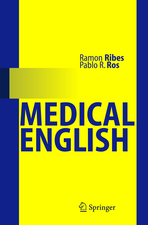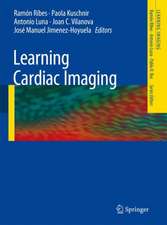Learning Genitourinary and Pelvic Imaging: Learning Imaging
Editat de Joan C. Vilanova, Antonio Luna, Pablo R. Rosen Limba Engleză Paperback – 23 noi 2011
Preț: 369.45 lei
Preț vechi: 388.90 lei
-5% Nou
70.69€ • 73.81$ • 58.51£
Carte disponibilă
Livrare economică 14-28 martie
Specificații
ISBN-10: 364223531X
Pagini: 260
Ilustrații: X, 230 p. 423 illus., 63 illus. in color.
Dimensiuni: 193 x 260 x 14 mm
Greutate: 0.44 kg
Ediția:2012
Editura: Springer Berlin, Heidelberg
Colecția Springer
Seria Learning Imaging
Locul publicării:Berlin, Heidelberg, Germany
Public țintă
Professional/practitionerCuprins
Kidney.- Adrenal.- Urinary Bladder, Collecting System and Urethra.- Prostate and Seminal Vesicles.- Scrotum.- Obstetrics.- Uterus.- Cervix and Vagina.- Adnexa.- Retroperitoneum.
Recenzii
“The book is well structured and contains many of the need-to-know abnormalities and their imaging characteristics. … The images contained within the pages of this book are some of the best that I have seen in a case-based review series. … I would recommend this book to anyone wanting to learn and understand this topic. Radiology residents who are studying for the oral board examination as well as the new core examination will find this text especially helpful during their studies.” (Jamie R. Ledford, Radiology, Vol. 266 (2), February, 2013)
Textul de pe ultima copertă
This introduction to genitourinary and pelvic radiology is a further volume in the Learning Imaging series. Written in a case-based format, the book is subdivided into ten chapters: kidney; adrenal gland; urinary bladder, collecting system and urethra; prostate and seminal vesicles; scrotum; obstetrics; uterus; cervix and vagina; adnexa and retroperitoneum. Genitourinary radiology has undergone a tremendous change owing to advances in ultrasound, CT and MRI that have redefined our understanding of genitourinary and pelvic pathology. Each chapter includes an introduction and ten case studies with illustrations and comments from anatomical, physiopathological and radiological standpoints and with bibliographic recommendations. Learning Genitourinary and Pelvic Imaging will be of value for radiologists, radiology residents, medical students and anybody else working in genitourinary and pelvic pathology.
Learning Imaging is a unique case-based series for those in professional education in general and for physicians in particular.
Caracteristici
Presents the current imaging appearances of the common lesions
Provides an overview of imaging techniques
Descriere
This introduction to genitourinary and pelvic radiology is a further volume in the Learning Imaging series. Written in a case-based format, the book is subdivided into ten chapters: kidney; adrenal gland; urinary bladder, collecting system and urethra; prostate and seminal vesicles; scrotum; obstetrics; uterus; cervix and vagina; adnexa and retroperitoneum. Genitourinary radiology has undergone a tremendous change owing to advances in ultrasound, CT and MRI that have redefined our understanding of genitourinary and pelvic pathology. Each chapter includes an introduction and ten case studies with illustrations and comments from anatomical, physiopathological and radiological standpoints and with bibliographic recommendations.



















